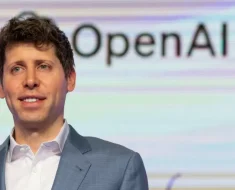Remote work has become a part of everyday life for many of us. Whether you’re working from home full-time or just a few days a week, chances are you’ve had to deal with some of the challenges that come with it—constant emails, endless scheduling, juggling multiple apps. It can get overwhelming. But what if there was a way to make all of that easier? Enter Claude AI models, developed by Anthropic, which might just change how we work remotely. With its new “computer control” feature, Claude AI could take over some of those repetitive tasks, freeing up your time to focus on what really matters.
Let’s break down how Claude AI could reshape remote work and why it’s worth paying attention to.
What Is Claude AI’s Computer Control Feature?


So, what exactly is this “computer control” feature? In simple terms, it allows Claude AI models to interact with your computer like a human would. It can move your mouse, click on buttons, type out text, and even switch between applications. Imagine having an assistant who can handle everything from opening your email to scheduling meetings and even filling out forms—all without you doing a thing¹’².
For example, say you need to schedule a Zoom meeting with five different people. Normally, you’d have to check everyone’s availability, send out invites, and follow up if someone doesn’t respond. With Claude AI models, you could just tell it to handle the whole process. It would check everyone’s calendars, send out the invites, and even remind people who haven’t responded yet³.
This feature is still in its early stages and has some limitations (like struggling with scrolling or zooming), but it’s already showing huge potential for making our work lives easier¹’².
How Could Claude AI Models Change Remote Work?


1. Automating Tedious Tasks
Let’s be honest—nobody enjoys spending hours on administrative tasks like scheduling meetings or responding to emails. These are the kinds of things that eat up your time and leave you feeling drained by the end of the day. What if you didn’t have to deal with them anymore?
With Claude AI models, you could automate these tasks completely. Imagine telling Claude to schedule your weekly team meeting or draft responses to routine emails as you focus on more important work. It could even handle more complex workflows like filling out expense reports by pulling data from different sources on your computer³.
By handling these repetitive tasks, Claude AI models could free up hours in your day for more meaningful work.
2. Managing Multiple Applications Seamlessly
One of the biggest challenges of remote work is managing all the different apps we use—email clients, project management tools, spreadsheets—you name it. Switching between them constantly can be exhausting and makes it easy to lose track of what you’re doing.
Claude AI models can help by acting as a bridge between these apps. For instance, let’s say you’re working on a project that requires data from a spreadsheet and updates in your project management software. Instead of manually copying and pasting information between the two apps, you could ask Claude to do it for you⁴.
This kind of multitasking is especially useful for freelancers or small business owners who wear many hats and need to stay on top of everything at once.
3. Streamlining Workflows
Claude AI models don’t just handle simple tasks—it can also take care of multi-step processes that would normally require several back-and-forths between different apps or people. For example, if you’re organizing an event or coordinating a project across teams, Claude can send out invitations, track responses, and update calendars automatically².
Even developers are starting to use Claude AI models for coding tasks. Companies like Replit are already integrating Claude into their workflows to automate repetitive coding processes⁵. By letting an AI handle the grunt work—like running tests or fixing minor bugs—developers can focus on more creative problem-solving.
4. Minimizing Human Error
We all make mistakes—especially when we’re juggling too many things at once. Whether it’s sending an email to the wrong person or double-booking a meeting room, errors happen when you’re overwhelmed with details.
Claude AI models could help reduce these mistakes by handling routine tasks with precision⁶. As long as you give it clear instructions and access to the right data, it can take care of things like scheduling meetings or entering data into spreadsheets without missing a beat.
Of course, no system is perfect—Claude has been known to make errors when interpreting certain commands—but as the technology improves over time, we can expect fewer mistakes¹.
The Challenges Ahead


While there’s no doubt that Claude AI models offer exciting possibilities for remote work automation, there are still some hurdles that need addressing before they become part of our everyday routines.
1. Security Concerns
One big question is security: How safe is it to let an AI control your computer? Since Claude can access files on your computer and interact with web browsers or other applications, there’s always a risk that private information could be exposed accidentally⁷.
Anthropic has put safeguards in place—like restricting access during certain sessions—but users will still need to be careful about what data they allow Claude to access⁸.
2. Occasional Errors
As impressive as Claude AI models are at mimicking human interactions with computers, they’re not perfect yet. The model still struggles with actions like scrolling through long documents or zooming in on content⁹. Plus, since it relies on screenshots rather than live video feeds for interacting with computers, it might miss quick notifications or pop-ups¹⁰.
These limitations mean that users might need to double-check some tasks completed by Claude until further improvements are made.
3. Learning Curve
Finally, there’s a bit of a learning curve involved in using an AI tool like Claude effectively. While it promises increased efficiency once set up properly, users will need time to figure out how best to communicate with the model and which tasks are best suited for automation.
For those who aren’t familiar with advanced AI tools (which is still most people), this might require some initial effort before seeing its full potential in action.
Conclusion: Is Claude AI Ready for Remote Work?


So could Claude AI models really be the future of remote work? The short answer: potentially! With its ability to automate tedious tasks like scheduling meetings or responding to emails—and even handle more complex workflows across multiple applications—Claude offers a glimpse into how our workdays might look in the near future¹’²’³.
However, challenges like security concerns and occasional errors mean we’re not quite at the point where we can hand over all our daily responsibilities just yet⁷’⁹’¹⁰. But as Anthropic continues refining its models based on user feedback—and as more companies start adopting these tools—the future of remote work might very well involve AIs like Claude working alongside us every step of the way.
Citations:
1. “Claude Can Now Control Your Computer—What Can Go Wrong?” BDTechTalks.
2. “Claude 3.5 Sonnet Can Control Your Computer.” TechRepublic.
3. “Introducing Computer Use: A New Claude 3.5 Sonnet.” Anthropic News.
4. “Anthropic’s Upgraded Claude AI Model Outperforms OpenAI-o1.” Windows Central.
5. “Anthropic’s Latest AI Model Can Use a Computer Just Like You.” ZDNet.
6. “Anthropic’s New Computer Control Features.” MoneyCheck.
7. “Developing a Computer Use Model.” Anthropic News.
8. “Anthropic Launches Smarter Claude Models.” The Decoder.
9. “Anthropic’s Latest Model Can Use Computers Independently.” BGR.
10. “Maximizing Efficiency with Claude AI: The Future of Workplace Automation.” ClaudeAI Wiki.





